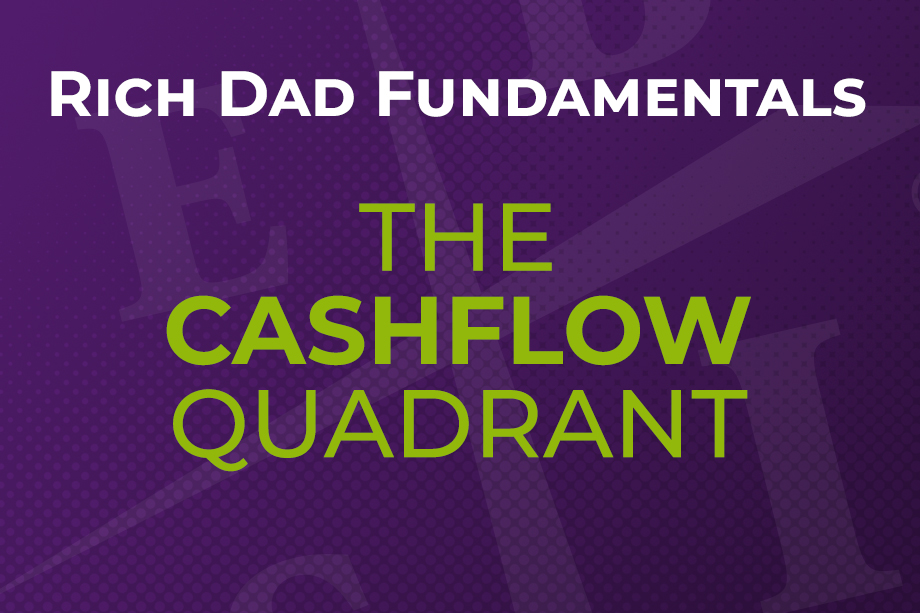In today’s world, there are new rules of money. Think of all the changes that have happened in the world over the last 40 years. How could anyone think that the way to get ahead today is by doing things the same way their parents did them?
Robert Kiyosaki wrote about the new rules of money in his book Conspiracy of the Rich. Below are the 8 new rules that everyone needs to learn if they have any hope of thriving in today’s world:
Rule #1 – Money is knowledge
Rule #2 – Learn how to use debt
Rule #3 – Learn how to control cash flow
Rule #4 – Prepare for bad times and you will only know good times
Rule #5 – The need for speed
Rule #6 – Learn the language of money
Rule #7 – Life is a team sport; choose your team carefully
Rule #8 – Since money is becoming worth less and less, learn to print your own
Learning these new rules of money will help you navigate a drastically different world. Though you have a strong chance of becoming a successful entrepreneur, you can’t do it the old way. You can’t rely on your parents’ advice and rules.
Two categories of people
In order to thoroughly understand the new rules of money, you need to understand that there are two categories of people in the world, those who see the world through the left side of Rich Dad’s CASHFLOW Quadrant and those who see it through the right side.

The CASHFLOW Quadrant is divided into four types of people, each representing the four different ways to make money.
- Employee
- Small business/self-employment
- Big business
- Investing
Every person who generates income resides in at least one of the four sections (quadrants), and where you are is determined by where your cash comes from.
The left side of the CASHFLOW Quadrant
Many people are employees who rely on paychecks. Others might be self-employed. Employees and self-employed individuals reside on the left side of the CASHFLOW Quadrant. The right side is reserved for those individuals who receive their cash from businesses or investments they own.
The Es and Ss pay the most in taxes and trade their time for money. And each has a different mindset.
E is for employee
At the end of the day, the most important thing for employees is security. Robert’s poor dad was an employee his entire life and he craved nothing more than security. Ultimately, he couldn’t understand why Robert would want to be a business owner and investor. To him, there was nothing riskier than that.
Because employees shy away from risk, they don’t see the need to learn about money or how it works. For them, education is about learning the skills needed to get a steady, high-paying job with great benefits.
When employees need more money, they look for a higher-paying job.
S is for self-employed
People in the self-employed quadrant are not good employees and often have the attitude that no one can do it better than them. While they still like the idea of security, they have a larger tolerance for risk, and thus don’t mind working for themselves. In fact, they like it that way because they feel in control of their future.
People in the S quadrant are doctors, lawyers, dentists, accountants, and other service-based businesses and consultants. They have very high-standards for their work and because of this, they have a hard time delegating to others. Again, they don’t like to hire employees because nobody does it better than them. As a result, they only make money when they are working. This means they don’t own a business, they own a job.
When self-employed people need more money, they look for more hours they can bill.
The right side of the CASHFLOW Quadrant
On the right side of the quadrant are Bs and Is. While financial freedom can be found in all four of the quadrants, the skills of a B or I will help you reach your financial goals more quickly.
In the B quadrant, people are working for you; in the I quadrant, your money is working for you. They also pay the least in taxes and create or invest in assets that produce cash flow for them even when they’re sleeping.
B stands for Business Owner
Unlike those in the S Quadrant, business owners don’t own a job. They own a system or a product that makes money even when they aren’t working. Because they know they can’t be successful on their own, business owners look to hire people who specialize in skills needed for the business and hire those who have more talent and skill than them. They look to delegate as much as possible, not keep all the work for themselves. The best business owners know they could leave their company for a year and come back to find it still profitable and running better than they left it.
Business owners are often seen as risk takers, but from the perspective of a business owner, being an employee is riskiest because employees have no control. A business owner can make the decision to do layoffs or fire an employee, but no one can take the business away from the business owner. And when the economy takes a down-turn, the business owner has the most control to make the business work and survive.
When business owners need more money, they create a new product or create or acquire a new system that produces money.
I stands for Investor
Investors have the highest financial education of anyone in the CASHFLOW Quadrant. They are adept at finding assets that provide steady income in the form of cash flow and they often use other people’s money (OPM) to attain those assets. They then use income from those assets to acquire even more assets, growing their wealth through this velocity of money. They enjoy the most in tax breaks, don’t have to work at all if they desire, and don’t have to deal with managing employees. The richest people in the world are investors, and as a general principle 70% of their income comes from investments with the other 30% made up of wages.
When investors need more money, they look for an opportunity to acquire an asset that produces more passive income.
The cost of choosing security over freedom
Remember, true entrepreneurs aren’t comfortable.
The truth is, comfort can be fleeting. Problems, changes, and unforeseen incidents are common and can come at the most inconvenient of times. True entrepreneurs would absolutely never consider taking a well-paid and “secure” job for comfort over chasing their own dreams to build something. In fact, the goal of a true entrepreneur is to build a company that will eventually produce revenue without them.
The dividing line between many who struggle financially and those who are prospering is the line between the two sides of the CASHFLOW Quadrant.
As you may have noticed, the wages of the poor and the middle class have either held steady or shrunk over the last couple decades. Yet, those on the left side of the quadrant continue to think they are living in security while looking at those who own businesses and invest as risk takers.
The sad reality is that those who operate on the left side of the quadrant pay more in taxes and pay more in interest on debt for liabilities the more they make. It is a vicious cycle that keeps them feeling poor—what we at Rich Dad call the Rat Race.
To understand why Es and Ss don’t get rich, you have to understand the difference in financial intelligence between the two.
What really makes you rich
How much money you make does not make you rich. Rather, how much money you keep is what makes you rich.
Those on the right side of the CASHFLOW Quadrant pay the least in taxes, know how to use debt to make money, and hedge against inflation through their assets. They not only make more money than employees and self-employed, but they also definitely keep more money.
Those on the left side of the quadrant work for what is called earned income. It is the highest taxed income. They have little-to-no tax shelters. Those on the right side work for passive income, the least taxed income. They have many tax breaks in the tax code they can use to their advantage.
The mindset we are taught vs. the mindset we create
In Robert’s book, Why “A” Students Work for “C” Students, he writes about how every child has a genius in them—the one thing that lights up their life, motivates them, feeds their dreams, and challenges them. Unfortunately, school often does not recognize the genius in our children. And even more, school may even crush a child’s genius.
This is because our educational system teaches one way of doing things—one mindset—that of the left side of the CASHFLOW Quadrant.
Our kids are told to go to school and get a good job. The problem, of course, is that they don’t know what they really want to do and are called to do yet when they hear this, so our kids chase down paths that are prescribed for them, like doctor, lawyer, teacher, and more—jobs in the E or S quadrant of the CASHFLOW quadrant.
As they grow older, they are trapped in the rat race. Because they go to college and take on debt, they have to get a high paying job. Soon they buy a house, and because of that debt, they must keep working. Then other expenses like kids, health care, and more paint them into a corner. Before you know it, the dreams of youth are gone, replaced with what for some is a miserable reality of work that is not soul-giving.
The school system does not help us discover our genius. And in the process of chasing other peoples’ dreams for our lives, we often lose our genius.
In another book Robert wrote, The CASHFLOW Quadrant, he talks about the importance of finding our own path—of changing your mindset about life and money. It’s not easy. We can often get lost in the process, and it’s not always simple to find our way back. But finding our path—releasing our inner genius, and the genius of our children—is essential to a happy life.
How about you? How is your path going? Do you find yourself making these types of statements?
“I love what I do, but I wish I could make more money.”
“I can’t wait for the weekend.”
“I want to do my own thing.”
“Is it quitting time yet?”
If so, it may be time to change your mindset and find a new path. To discover your life’s purpose, why you were given this gift called life, and what the gift is that you should give back to the world.
Moving from the left quadrant to the right quadrant
If you want to move from to the right side of Rich Dad’s CASHFLOW Quadrant, here’s some help on changing your mindset.
A while back, a study was conducted that showed the mindset of those who moved from poverty into wealth. Three things were seen to be a determining factor:
- They maintained a long-term vision and plan
- They believed in delayed gratification
- They used the power of compounding in their favor
The study also analyzed those who were once wealthy and became poor. These were the three factors that came into play:
- They had short-term vision
- They had a desire for instant gratification
- They abused the power of compounding
Very simply, the path to the right side of the quadrant starts with thinking in terms of acquiring assets that produce passive income rather than living in a pattern of paycheck to paycheck. Start small, have patience, and watch as your wealth grows over time.
If you’re going to invest the time and money to learn something new, then focus on learning how to operate on the B and I side of the CASHFLOW Quadrant. No degree program will teach you how to be a successful investor. But you can teach yourself by reading Rich Dad’s CASHFLOW Quadran t and attending some of our workshops. Sure, an investment of time and money is required, but you’ll experience a much better return on your investment than you would with a traditional education.





